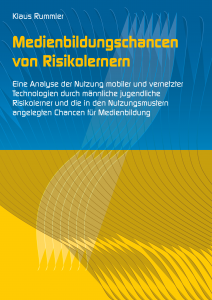Out now: Potentials for media education of at-risk learners
Potentials for media education of at-risk learners
An analysis of the use of mobile and networked technologies by male adolescents and the potentials for media education inherent in these usage patterns Klaus Rummler, 2012The central concern of this book is the media education and support of young people, particularly boys, from problem families or with disadvantaged socio-cultural backgrounds, the so-called new underclass or secondary school students, respectively. Those learners often do not meet the requirements for a qualifying degree, lack basic skills in terms of the PISA studies, have a rejective and distant attitude towards school or have a difficult socio-economic background. The concept of “at-risk learners” tries to grasp this group, which are mostly boys and often from migrant backgrounds. The approach and the question of at-risk learners opens the view and reveals skills and cultural resources, with which at-risk learners manage to use media in a self-directed and reflective way for their own personal development and their coping with everyday life (Niesyto, 2010, p. 315).
The central theme and task of this book is to outline educational opportunities within the media usage patterns of at-risk learners. From a theoretical perspective, the question is, how and by which patterns at-risk learners appropriate media as cultural objects. Linked to the idea of education (German: Bildung), the pedagogically guiding question is: How are the development and thus the learning processes of at-risk learners connected with their patterns of media usage and media appropriation?
The question regarding opportunities for media education of at-risk learners is founded on the theory of media education (German: Medienbildung) and the approach of Socio-Cultural Ecology, which was developed by the London Mobile Learning Group (LMLG; www.londonmobilelearning.net) (Pachler, Bachmair, & Cook, 2010). Based on these two theories, this book tries to position the group of at-risk learners in the context of lifeworld and life situations and to classify this specific group of learners with reference to individual, educational, and social risks.
The gender perspective reveals certain patterns of appropriation associated with specific media and allows for educational opportunities for boys to be formulated more precisely. A key result concerning new developments in boys’ everyday life is the dissolution of hegemonic masculinity and its transformation to multi-optional and situated masculinities that must be balanced by boys.
The analysis of social structures serves as a methodological approach to systematically identify at-risk learners within society. It helps to appropriately describe social segmentation by using the results of the analysis concerning media use and coping strategies with everyday life. This media education research is a reconstruction of media use based on trails of articulation and appropriation processes, as they are represented in the consumption data. Thus, the underlying acquisitive patterns as well as the inherent educational opportunities are revealed.
In the perspective of social and aesthetic structures, at-risk learners are characterized by a rather hedonistic and resistive lifestyle, socially disadvantaged backgrounds, and active risk-taking. Furthermore, their patterns of media usage are opposed to formal forms of school learning. The key findings and thus opportunities for media education of at-risk learners are to be found in three clusters of media use patterns: the downloading, storing, and exchanging of a variety of media and file formats; (mobile) gaming; the producing and processing of a variety of audio and visual material. These patterns are linked to three considerable educational opportunities: at-risk learner-generated alternative spaces of media education that are structurally set against the learning environment school and its specific forms of appropriation and learning; communicative organization of their own everyday life and media use; the generation of digital collections and archives as personal property.
ISBN: 978-3-00-040452-8
ISBN-A: 10.978.300/0404528
doi: dx.doi.org/10.978.300/0404528
Fulltext as PDF:
urn:nbn:de:hebis:34-2012120642264
